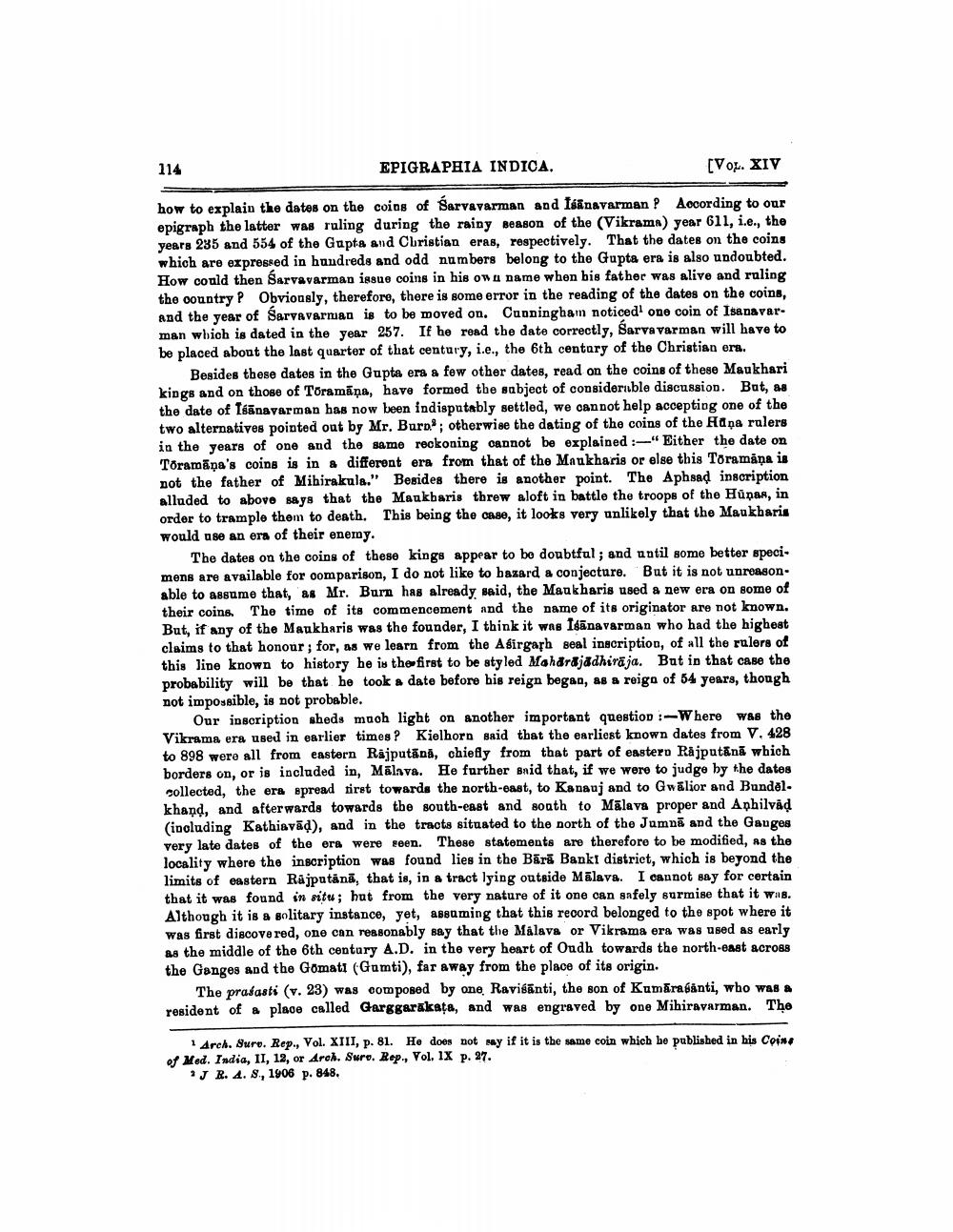________________
114
EPIGRAPHIA INDICA.
[VOL. XIV
how to explain the dates on the coins of Sarvavarman and Isänavarman ? According to our epigraph the latter was ruling during the rainy season of the (Vikrama) year 611, i.e., the years 295 and 554 of the Gupta and Christian eras, respectively. That the dates on the coins which are expressed in hundreds and odd numbers belong to the Gupta era is also undoubted. How could then Sarvavarman issue coins in his own name when bis father was alive and ruling the country? Obviously, therefore, there is some error in the reading of the dates on the coins, and the year of Sarvavarnian is to be moved on. Cunningham noticed one coin of Isanavarman which is dated in the year 257. If he read the date correctly, Sarva varman will have to be placed about the last quarter of that century, i.e., the 6th century of the Christian era.
Besides these dates in the Gupta era a few other dates, read on the coins of these Maukhari kings and on those of Toramāņa, have formed the sabject of considerable discussion. But, as the date of Tsānavarman has now been indisputably settled, we cannot help accepting one of the two alternatives pointed out by Mr. Burp®; otherwise the dating of the coins of the Adņa rulers in the years of one and the same reckoning cannot be explained :-"Either the date on Toramāna's coins is in a different era from that of the Mankharis or else this Toramåņa is not the father of Mihirakula." Besides there is another point. The Aphsad inscription alluded to above says that the Maukharis threw aloft in battle the troops of the Hūņas, in order to trample them to death. This being the case, it looks very unlikely that the Maukharis would use an era of their enemy.
The dates on the coins of these kings appear to be doubtful; and until some better speci. mens are available for comparison, I do not like to bazard a conjecture. But it is not unreason. able to assume that, as Mr. Burn has already said, the Maukharis used a new era on some of their coins. The time of its commencement and the name of its originator are not known. But, if any of the Maukharis was the founder, I think it was Igānavarman who had the highest claims to that honour; for, as we learn from the Asirgarh seal inscription, of all the rulers of this line known to history he is the first to be styled Maharajadhiraja. But in that case the probability will be that he took a date before his reign began, as a reiga of 54 years, though not impossible, is not probable.
Our inscription sheds mooh light on another important question :-Where was the Vikrama era used in earlier times? Kielhorn said that the earliest known dates from V. 428 to 898 were all from eastern Rajputāna, chiefly from that part of eastero Rajputānā which borders on, or is included in, Mālava. He further said that, if we were to judge by the dates collected, the era spread tiret towards the north-east, to Kanauj and to Gwalior and Bundel. khand, and afterwards towards the south-east and south to Malava proper and Aphilvad (including Kathiavād), and in the tracts situated to the north of the Jamnā and the Ganges very late dates of the ers were seen. These statements are therefore to be modified, as the locality where the inscription was found lies in the Bārs Bankı district, which is beyond the limits of eastern Rajputanã, that is, in a tract lying outside Mālava. I cannot say for certain that it was found in situ; hut from the very nature of it one can safely surmise that it was. Although it is a solitary instance, yet, assuming that this record belonged to the spot where it was first discovered, one can reasonably say that the Malava or Vikrama era was used as early as the middle of the 6th century A.D. in the very heart of Oudh towards the north-east across the Ganges and the Gomati (Gamti), far away from the place of its origin.
The prasasti (v. 23) was composed by one Raviganti, the son of Kumaraganti, who was a resident of a place called Garggarakata, and was engraved by one Mihiravarman. The
1 Arch. Sure. Rep., Vol. XIII, p. 81. He does not say if it is the same coin which be published in his Coins of Med. India, II, 12, or Arol. Sure. Rep., Vol. IX p. 27.
'JR. 4. 8., 1906 p. 848.




